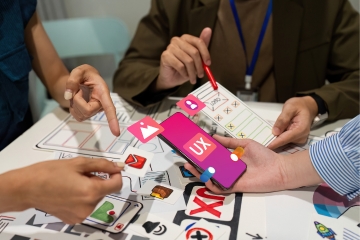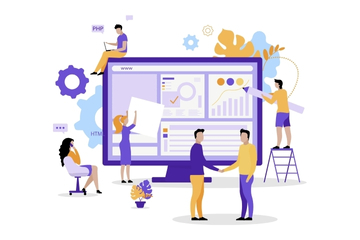
Design Thinking in App Development: Creating Solutions that Users Love
Introduction
In today’s competitive landscape, design thinking has emerged as a revolutionary approach in app development. By focusing on user-centric solutions, design thinking ensures that applications not only meet but exceed user expectations. This methodology bridges the gap between technical capabilities and user needs, creating intuitive and engaging apps. Let's delve into how design thinking shapes the world of app development and why it is integral to crafting solutions that users love.
Understanding Design Thinking
Design thinking is a problem-solving approach that involves understanding user needs, brainstorming innovative solutions, prototyping, and iterating based on user feedback. It emphasizes empathy, ideation, and experimentation. For app developers, this means prioritizing user experience (UX) and creating applications that are not just functional but also enjoyable to use.
Empathy: The Foundation of Design Thinking
At the core of design thinking is empathy. Developers must step into the users' shoes to understand their pain points, behaviors, and preferences. This involves thorough research, including user interviews, surveys, and observing user interactions with existing products. By gaining deep insights into the target audience, developers can create apps that resonate with users on a personal level.
Ideation: Generating Innovative Solutions
Once developers understand the user needs, the next step is ideation. This phase involves brainstorming a wide range of ideas, without constraints. The goal is to think creatively and explore unconventional solutions. Techniques such as mind mapping, sketching, and collaborative workshops can be highly effective. The key is to foster an environment where all ideas are welcome, encouraging out-of-the-box thinking.
Prototyping: Bringing Ideas to Life
Prototyping is the process of turning ideas into tangible representations. In app development, this can range from simple wireframes to interactive digital prototypes. Prototypes allow developers to visualize and test their ideas quickly. By creating low-fidelity prototypes early on, teams can gather user feedback and make necessary adjustments before investing significant time and resources into development.
Testing: Iterating Based on Feedback
Testing is a critical phase where prototypes are put to the test with real users. This phase is all about gathering feedback, identifying flaws, and understanding how users interact with the app. Testing can involve usability testing sessions, A/B testing, and beta releases. The insights gained during this phase are invaluable, guiding developers to refine and enhance the app to better meet user needs.
Implementation: Developing the Final Product
With validated prototypes and comprehensive user feedback, developers move to the implementation phase. This involves coding the app, integrating features, and ensuring robust performance. Adopting an agile development approach can be beneficial, allowing teams to work in iterative cycles, continuously refining the product. Throughout this phase, maintaining a focus on user experience is paramount.
Coding Course: Empowering Developers with Essential Skills
For aspiring app developers, enrolling in a coding course is a crucial step. Such courses provide foundational knowledge and hands-on experience in programming languages and development tools. By mastering coding skills, developers can bring their design thinking ideas to fruition, creating apps that are both functional and user-friendly.
App Development Course: Comprehensive Learning for Future Innovators
An app development course offers a comprehensive curriculum that covers all aspects of app creation, from ideation to deployment. These courses emphasize design thinking principles, teaching developers how to empathize with users, generate innovative ideas, prototype effectively, and test rigorously. Graduates of these courses are well-equipped to tackle real-world challenges and deliver exceptional app solutions.
Digital Marketing Course: Promoting Apps to the Right Audience
Developing a great app is only half the battle; promoting it effectively is equally important. A digital marketing course equips developers with the knowledge to market their apps successfully. By understanding SEO, social media marketing, and content strategy, developers can reach their target audience, increase downloads, and foster user engagement.
SEO Course: Enhancing App Visibility and Discoverability
Search engine optimization (SEO) is critical for app discoverability. An SEO course teaches developers how to optimize their app listings and content to rank higher in search results. By implementing SEO best practices, such as keyword optimization, meta descriptions, and backlinks, developers can improve their app's visibility, attracting more users and driving organic growth.
Case Study: Successful Application of Design Thinking
To illustrate the power of design thinking, let’s explore a case study. A team of developers was tasked with creating a fitness app. They began by conducting extensive user research, discovering that users desired a personalized experience tailored to their fitness levels and goals.
Empathy Phase
Through interviews and surveys, the team identified common pain points, such as lack of motivation and difficulty tracking progress. They also noted a demand for community features, where users could share achievements and support each other.
Ideation Phase
Armed with these insights, the team brainstormed features that would address these needs. Ideas included customizable workout plans, progress tracking, and a social platform for users to connect. They used mind mapping to organize these ideas and prioritize the most impactful ones.
Prototyping Phase
The team then created low-fidelity wireframes, focusing on the user journey and interface design. These wireframes were turned into interactive prototypes, allowing users to navigate through the app and provide feedback.
Testing Phase
During testing, users appreciated the personalized workout plans but found the progress tracking feature cumbersome. The team iterated on the design, simplifying the tracking process and enhancing the user interface based on feedback.
Implementation Phase
Finally, the app was developed using agile methodologies, with continuous testing and refinement. The result was a user-centric fitness app that not only met but exceeded user expectations, demonstrating the efficacy of design thinking in app development.
Conclusion
Design thinking is a powerful approach that ensures app development is user-centric, innovative, and effective. By focusing on empathy, ideation, prototyping, and testing, developers can create solutions that users truly love. Coupled with courses in coding, app development, digital marketing, and SEO, developers can enhance their skills and succeed in the competitive app market. Embracing design thinking is the key to developing apps that stand out, resonate with users, and achieve lasting success.

No Experience? No Problem. Here's Why a Basic Computer Course Could Be Your Best First Step

Design Your Future: Why a Graphic Design Course Is More Than Just Art

Why Every Student - No Matter the Degree - Should Learn to Code

From Learner to Innovator: How a Mobile App Development Course Can Accelerate Your Career

Your Passion, Your Code, Your Triumph: Learn Programming to Conquer Your Fears

Turn Your Imagination into Income: Why Graphic Design Is the Skill You Need Now

Own Your Destiny: Why Every Student Must Learn SEO & Digital Marketing Now

Feeling Lost After 12th? Discover How Mobile App Development Can Shape Your Bright Future

What They Don’t Teach in YouTube Tutorials: 5 Web Development Secrets Only Real Courses Offer

Dreaming of a Career in Tech? Start Here with Our Programming & Development Course

Can You Learn Computers Without Any Experience? YES, and Here’s How

Tired of Feeling Left Behind? Learn Digital Marketing and Take Control of Your Future